What are the Different Types of Plaid? A Simple Guide
Plaid is a pattern made of stripes going up and down and side to side that cross over each other. The stripes can be different widths and colors, creating a checked or boxed look. When the colored stripes cross, they make new, blended colors.
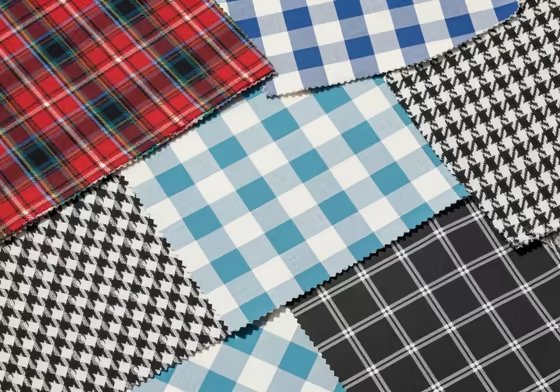
These patterns can be woven right into the fabric or just printed on top. But this simple pattern causes a lot of confusion. The biggest mix-up is between the words "plaid" and "tartan."
The difference comes down to history and where you are. In North America, "plaid" is the word we use for almost any fabric with this crisscross pattern. This happened because of a historical mistake.
In Scotland, the word "plaid" doesn't mean the pattern at all. It's the name for a garment, like a large blanket worn over the shoulder. The actual word for the pattern in Scotland is "tartan."
So, Scottish people wore "plaid" blankets that had "tartan" patterns. When these were sold in America, people started calling the pattern "plaid" instead of the blanket. This took away the pattern's cultural meaning.
The main difference is that "plaid" is a general name for any grid pattern with stripes. A " tartan " is a specific type of plaid that is tied to a Scottish clan, family, or group. Each tartan has a name and a specific, repeating pattern.
Here's an easy way to remember it: All tartans are types of plaid, but not all plaids are tartans. Understanding this is the key to telling all these patterns apart.
Tartan: The Famous Scottish Plaid
A tartan is a pattern with crisscrossing stripes in many colors, usually woven from wool. What makes it different from a regular plaid is its "sett."
The sett is like the tartan's DNA. It's the exact recipe of threads and colors that creates the pattern. This sett is written down as a "thread count," which lists how many threads of each color are used.
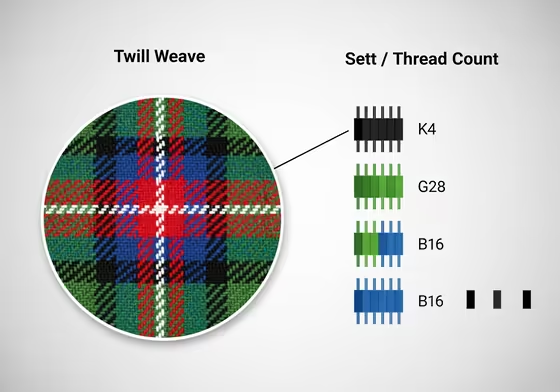
Most tartans are made with a special diagonal weave called a twill weave. This is the same weave used for denim jeans. This weave creates a "half-tone" where colors cross, giving tartan its unique depth.
Tartan is deeply connected to Scottish identity. While the idea of tartan is ancient, the system of matching specific patterns to specific clans became popular in the 1800s. Before then, patterns were usually based on the plants and berries used for dyes in a local area.
After a Scottish rebellion in 1745, the British government banned Highland men from wearing tartan. This made tartan a powerful symbol of Scottish pride and rebellion.
Today, tartan is officially protected. The Scottish government created the Scottish Register of Tartans to keep a public record of all official tartan designs. This makes tartan much more than just a pattern; it’s a piece of cultural history.
Famous Tartan Patterns
Some tartans have become famous around the world. Their stories show how a simple pattern can become a powerful symbol.
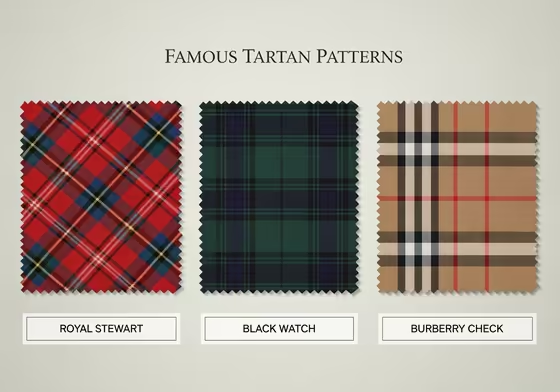
-
Royal Stewart Tartan
This is probably the most recognized tartan in the world. It has a bright red background with lines of yellow, blue, black, and white. It's the personal tartan of the British monarch and is connected to the royal House of Stewart.
Because it represented the British establishment, the 1970s punk movement adopted it as a symbol of rebellion. Punks would rip up clothing with the Royal Stewart Tartan to make a statement. This turned a symbol of authority into a symbol of anarchy. -
Black Watch Tartan
This is a dark, simple pattern made of dark blue, forest green, and black. Its story is a military one. It was created as a uniform for soldiers who "watched" the Scottish Highlands after the rebellions.
The dark colors worked as camouflage and gave the regiment its name, "Black Watch." Today, it's a popular pattern in fashion because of its clean, classic look. -
Burberry Plaid (Haymarket Check)
This famous pattern has a camel-colored background with black, white, and red lines. It was created in the 1920s as the hidden lining for Burberry's trench coats. In the 1960s, Burberry started using it on scarves and other items, turning it into a global symbol of luxury.
Even though it's a corporate design, it is officially registered as a tartan with the Scottish Register of Tartans . The company protects it with trademarks, just like other company logos.
Other Well-Known Clan Tartans
Many Scottish families have their own unique tartan patterns. Here are a few more examples.
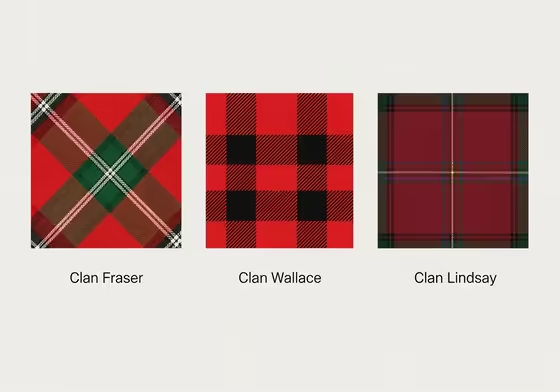
- Clan Fraser: The most common Fraser tartan is a bold red pattern with thick navy and green stripes. It also has thin white stripes.
- Clan Wallace: This pattern is usually bright red with wide black stripes and thin yellow lines. The clan was famously led by Sir William Wallace.
- Clan Lindsay: This tartan has a deep wine-red background. It is crossed with stripes of dark green and navy blue.
Classic Checks and Other Plaids
Now let's move away from tartans to other common plaids and checks. These patterns are defined by their structure and size, not by family history. They are the everyday patterns you see on shirts, jackets, and blankets.
Simple Two-Color Checks
This group of patterns shows how small changes in size and weave can create totally different looks.

-
Gingham
Gingham is a simple pattern of evenly sized squares. It is made with one color (like blue or red) and white. This creates three tones: white, a light color, and a darker color where the stripes cross.
Gingham is made with a basic over-under weave, which makes the fabric feel flat and crisp. It's often used for shirts, dresses, and tablecloths. -
Buffalo Check
Buffalo check is just a much larger version of gingham . It has big, bold blocks of two colors, usually red and black. Its large size is what makes it different from the small squares of gingham.
This pattern is often linked to the outdoors and "lumberjack" style flannel shirts. -
Shepherd's Check
From a distance, this pattern of small, even checks looks just like gingham. But up close, you can see its diagonal twill weave. This different weave gives it more texture and a different feel than gingham's flat weave. -
Checkerboard
This is the simplest check of all. It's just alternating squares of two solid colors, like a chessboard.
Windowpane and Grid Checks
These patterns are all about the lines, not the colored blocks. The background color shows through, creating a clean and open look.
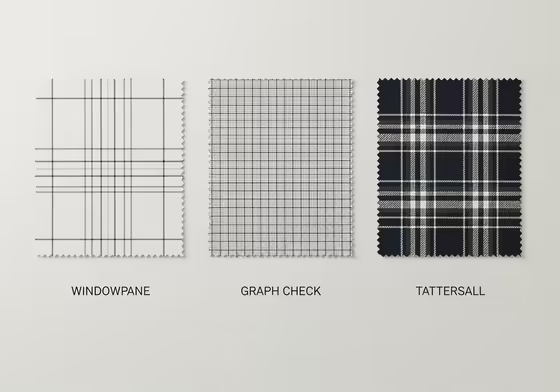
-
Windowpane
This is a simple pattern of thin lines that cross to form large, open squares. It looks like the panes on an old window. It's often used for suits and sport coats. -
Graph Check
This pattern is like windowpane but with a much smaller grid. The lines are packed more closely together, making it look like graph paper. -
Tattersall
Tattersall is a bit more complex. It has thin stripes in two or more alternating colors that cross on a light background. It's named after a London horse market that sold horse blankets with this pattern.
More Complex Patterns
This group includes some of the most interesting patterns. Their unique looks come from special weaving techniques or interesting histories.

-
Houndstooth
This pattern is made of broken, jagged checks that look like a four-pointed star or a tooth. It's usually seen in black and white. The tooth shape isn't printed; it's created by a specific combination of the weave and thread colors. -
Glen Plaid (Prince of Wales Plaid)
This is like a "plaid of plaids." It combines small and large checks into one pattern. Usually, a tiny pattern like houndstooth is overlaid with a larger windowpane check in a different color.
It became popular after the Duke of Windsor (Prince of Wales) started wearing it. This made it a symbol of sophisticated style. -
Gun Club Check
This pattern started in Scotland but got its name after an American shooting club used it for their uniforms in 1874. It uses earthy colors like rust, gold, and green to create a complex check. -
Madras
Madras is a lightweight cotton fabric known for its bright, summery colors. It comes from the city of Chennai, India. Authentic Madras is handwoven, which gives it a unique, slightly bumpy texture.
The patterns are often asymmetrical, and the original vegetable dyes were known to bleed, giving the fabric a soft, faded look over time. It's a classic choice for "preppy" summer style.
Patterns That Look Like Plaid
Argyle
Argyle is a pattern of interlocking diamonds with diagonal lines crossing over them. It's often mistaken for plaid because it also has Scottish roots. The design comes from the tartan of Clan Campbell of Argyll.
But argyle is not technically a plaid for a few key reasons.
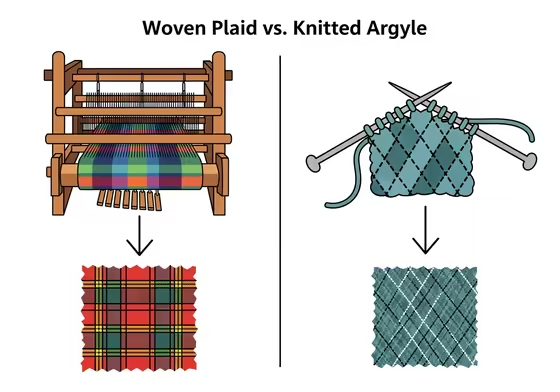
- It’s made of diamonds, not squares.
- It’s a knitted pattern, not a woven one. Plaid patterns are woven on a loom. Argyle is created by a special knitting technique called "intarsia," which allows for solid blocks of color next to each other.
So while it looks similar, Argyle is in its own category.
Plaid Pattern FAQ
What is the most famous plaid pattern?
Culturally, the Royal Stewart Tartan is the most famous. It's known as the Queen's tartan and was also used by punks for rebellion. Commercially, the Burberry check is one of the most recognized brand patterns in the world.
Are tartan and plaid the same thing?
No. "Plaid" is the general term for any pattern with crossing stripes. A " tartan " is a specific type of plaid that is connected to Scottish history and has a registered pattern. Remember, all tartans are plaids, but not all plaids are tartans.
What is the black and white plaid pattern called?
It could be one of several patterns:
- Houndstooth: Has a jagged, tooth-like shape.
- Shepherd's Check: Has small, even squares with a textured diagonal weave.
- Gingham: Has small, even squares with a flat weave.
- Checkerboard: Is a simple grid of alternating solid squares.
What is the diamond plaid pattern called?
That pattern is called Argyle. It’s not actually a plaid because it is knitted, not woven, and it's made of diamonds instead of squares.
Final Thoughts
The world of plaid is huge, from simple grids to complex patterns that represent a family's history. These designs are not random. They are defined by specific details.
These differences include:
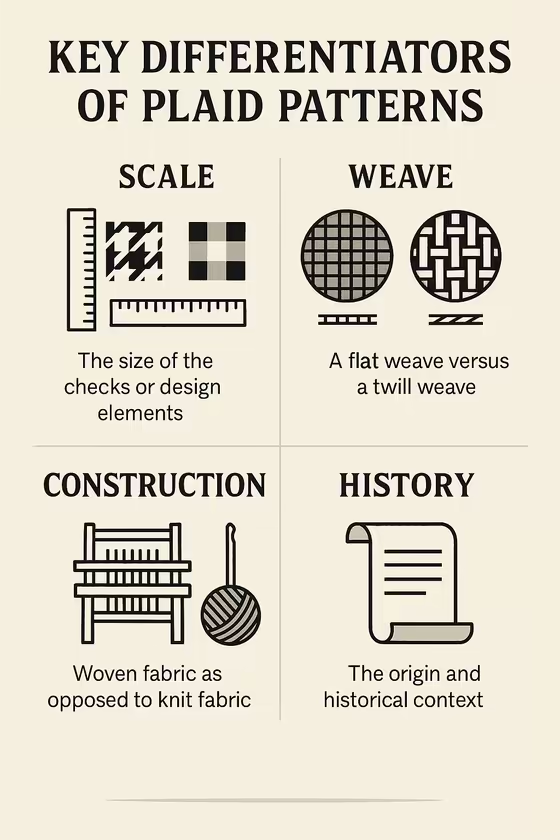
- Scale (like the tiny squares of Gingham vs. the large blocks of Buffalo Check)
- Weave (the flat weave of Gingham vs. the diagonal weave of Shepherd's Check)
- Construction (the woven grid of a Tartan vs. the knitted diamonds of Argyle)
- History (the handmade fabric of Madras vs. the clan history of Tartan)
From ancient fabrics to punk rock jackets and luxury brands, the simple idea of crossing lines has created some of the most lasting and meaningful patterns we have.